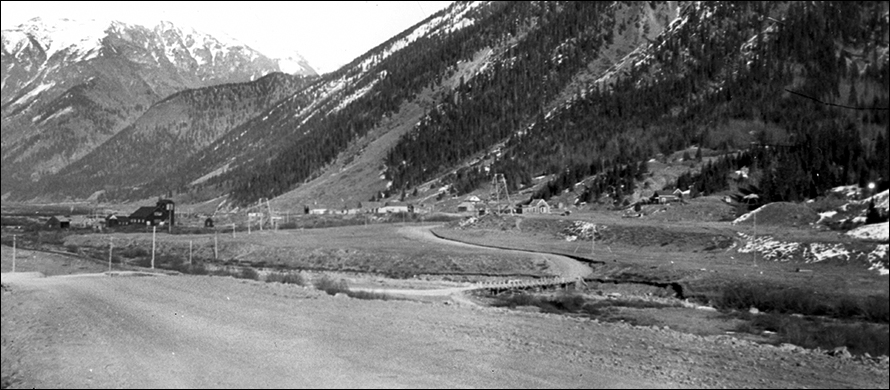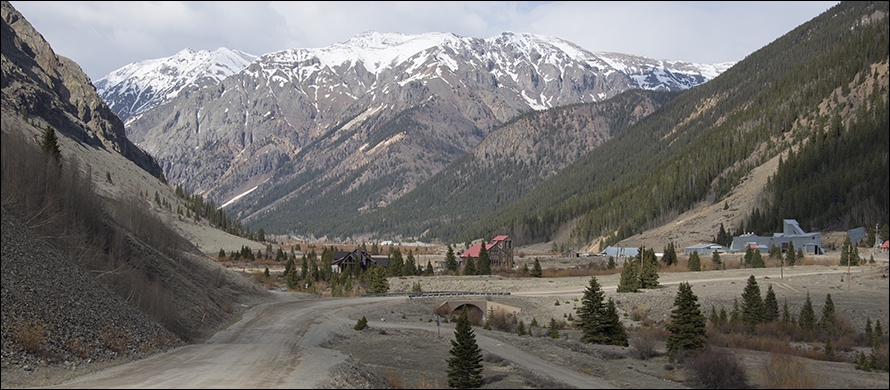
By John Sites...
During the Fall of 2008 my crew and I were fortunate to do preservation work on the Little Nation Mill and Tram building in Howardsville. The Historical Society received the building and mill site, as well as $25,000 for preservation work from members Fred and Nancy Clark. Bill and Julie Ogle also donated $5,000 towards the project.
The roadside landmark of the upper Animas Valley has been gradually deteriorating since it was last operated during the Second World War. Fred Clark acquired the property and re-roofed the building in the 1990's. This required some courage given the condition of the dilapidated plank siding and exterior wall framing. The primary timber frame however, was still in excellent shape, and probably would not be today if not for the roof work undertaken by Mr. Clark at that time.
The mill was built in 1921 by the Little Nation Mining Company to service the mine of the same name. The mine is located at 10,000 feet on King Solomon Mountain, roughly 500 feet above the valley floor. Ore was transported from mine to mill via a 2,900 foot aerial tramway. The two bucket "jig-back" tram is suspended on a 1-1/8 inch cable and driven by one 7-1/2 horsepower General Electric motor installed at the mine. The ore reduction mill, one of two of its kind left in the San Juans, was designed to handle fifty tons of ore per day with one operator and one helper.
The Little Nation Mine was receiving almost $25 a ton for her ore in those days. Unfortunately, the managers "robbed the right hand to pay the left" while building the mill and neglected development of the mine. When the mill was ready for service, the mine was far behind in ore production. As a result of this mismanagement, the mill itself only ran briefly before shutting down for good.
By the 1940's, the mill was obsolete, but the tram was still used to transport ore to the mill site, where it was loaded and trucked to the nearby Shenandoah-Dives Custom Mill. In 1953, the mine ceased operations due to falling metals prices after the war. More recent history places the mill in motion pictures such as "Night Passage" starring Jimmy Stewart. The towering structure is also a popular subject of photography and art. The Little Nation Mill was placed on the San Juan County Historic Register in 2007.
After reviewing the initial scope of work from the Historical Society and available photos, Fred Clark and I went through the building and prioritized items such as roof repair, floor repair and exterior wall repair. Our main goals were to get the building and grounds cleaned up, dried in and secured for general historic preservation. The original donations by the Clarks and Ogles, were not matched despite grant requests, therefore more extensive restoration work was not possible.
Despite the initial fears of under-funding, the grounds were cleaned up and walls appeared where they had not been seen in years. Roofing was screwed down and repaired where needed. The exterior walls were framed in with doors and windows and secured from the weather with felt paper and battens. Loose siding throughout the structure was secured and replaced, often with workers dangling from rope and harness. Four windows were installed on the south aspect to let in natural light. Floors were patched and cleared for storage. The walls and roof of the sorting bin area were replaced. The tram cables and their attachments to the structure and anchor were inspected and appeared to be very secure and left alone.
After this work had been done, there was some money left to patch up the old cabin adjacent to the mill site, which was part of the property donated by the Clarks. The cracks were "chinked" in the log structure with spruce wedges to mitigate wind driven moisture and keep possibly one of the oldest, if not the oldest structure on the western slope of Colorado around a few more years.
The goals of preservation of the Little Nation Mill and Tram building will be around for future generations to study and photograph by all, from history buffs to Jeepers.


